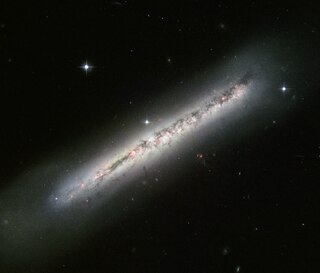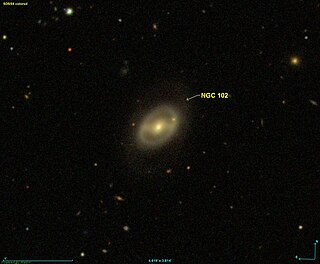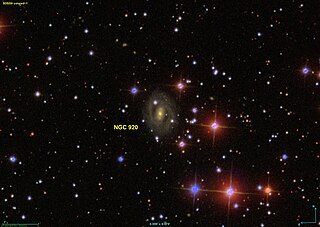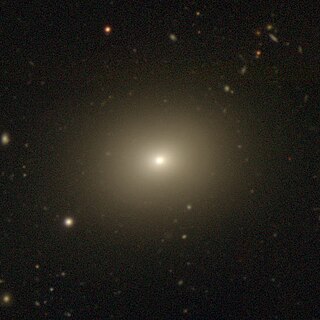
NGC 3632 and NGC 3626 is an unbarred lenticular galaxy and Caldwell object in the constellation Leo. It was discovered by William Herschel, on 14 March 1784. It shines at magnitude +10.6/+10.9. Its celestial coordinates are RA 11h 20.1m, dec +18° 21′. It is located near the naked-eye-class A4 star Zosma, as well as galaxies NGC 3608, NGC 3607, NGC 3659, NGC 3686, NGC 3684, NGC 3691, NGC 3681, and NGC 3655. Its dimensions are 2′.7 × 1′.9. The galaxy belongs to the NGC 3607 group some 70 million light-years distant, itself one of the many Leo II groups.

NGC 12 is an intermediate spiral galaxy in the Pisces constellation. It was discovered by William Herschel on December 6, 1790.

NGC 3554 is an elliptical galaxy in the constellation Ursa Major. It was discovered in December 1827 by John Herschel.

NGC 584 is an elliptical galaxy in the constellation Cetus. The galaxy was discovered on 10 September 1785 by the German-British astronomer William Herschel.

NGC 4634 is an edge-on barred spiral galaxy located about 70 million light-years away in the constellation of Coma Berenices. NGC 4634 was discovered by astronomer William Herschel on January 14, 1787. It is interacting with the spiral galaxy NGC 4633. Both galaxies are members of the Virgo Cluster.

NGC 3501 is a spiral galaxy 80 million light years away. It is located in the constellation Leo. The galaxy was imaged by the Hubble Space Telescope in 2014, showing an edge-on spiral galaxy; its companion NGC 3507 is not included in the photograph. It is a member of the NGC 3607 Group of galaxies, which is a member of the Leo II Groups, a series of galaxies and galaxy clusters strung out from the right edge of the Virgo Supercluster.

NGC 78 is a pair of galaxies in the constellation Pisces. NGC 78A, which is the more southern galaxy, is a barred spiral galaxy. NGC 78B, which is the more northern galaxy, is an elliptical galaxy. Although the designations NGC 78A and 78B are used today, the designation NGC 78 was formerly used mainly for the northern galaxy.

NGC 79 is an elliptical galaxy estimated to be about 270 million light-years away in the constellation of Andromeda. NGC 79 is its New General Catalogue designation. Its apparent magnitude is 14.9. It was discovered on 14 November 1884 by Guillaume Bigourdan.

NGC 81 is a lenticular galaxy estimated to be about 270 million light-years away in the constellation of Andromeda.

NGC 83 is an elliptical galaxy estimated to be about 260 million light-years away in the constellation of Andromeda. It was discovered by John Herschel in 1828 and its apparent magnitude is 14.2.

NGC 85 is an interacting spiral or lenticular galaxy estimated to be about 200 million light-years away in the constellation of Andromeda. It was discovered by Ralph Copeland in 1873 and its apparent magnitude is 15.7. The galaxy appears to be interacting with the companion spiral IC 1546.

NGC 96 is a lenticular galaxy estimated to be about 290 million light-years away in the constellation of Andromeda. It was discovered by Guillaume Bigourdan in 1884 and its apparent magnitude is 17.

NGC 97 is an elliptical galaxy estimated to be about 230 million light-years away in the constellation of Andromeda. It was discovered by John Herschel in 1828 and its apparent magnitude is 13.5.

NGC102 is a lenticular galaxy estimated to be about 330 million light-years away in the constellation of Cetus. It was discovered by Francis Leavenworth in 1886 and its apparent magnitude is 14.

NGC 1222 is an early-type lenticular galaxy located in the constellation of Eridanus. The galaxy was discovered on 5 December 1883 by the French astronomer Édouard Stephan. John Louis Emil Dreyer, the compiler of the New General Catalogue, described it as a "pretty faint, small, round nebula" and noted the presence of a "very faint star" superposed on the galaxy.

NGC 5470 is an edge-on spiral galaxy located between 43 and 68 million light-years away in the constellation Virgo. It was discovered by astronomer John Herschel in 1830. It is a member of the Virgo III Groups, a series of galaxies and galaxy clusters strung out to the east of the Virgo Supercluster of galaxies.

NGC 920 is a barred spiral galaxy in the Andromeda constellation. The celestial object was discovered on September 11, 1885 by the American astronomer Lewis A. Swift.

NGC 939 is a lenticular or elliptical galaxy in the constellation Eridanus. It is estimated to be 241 million light-years from the Milky Way and has a diameter of approximately 80,000 ly. NGC 939 was discovered on October 18, 1835 by astronomer John Herschel.

NGC 766 is an elliptical galaxy located in the Pisces constellation about 362 million light years from the Milky Way. It was discovered by British astronomer John Herschel in 1828.

NGC 5619 is an intermediate spiral galaxy in the constellation Virgo. The galaxy was found on April 10, 1828 by the British astronomer John Herschel. It is located about 390 million light-years away from the Sun.




















